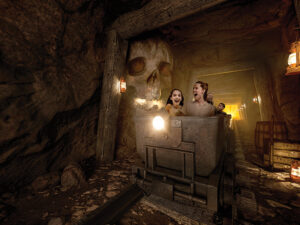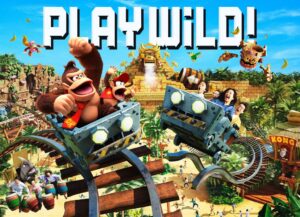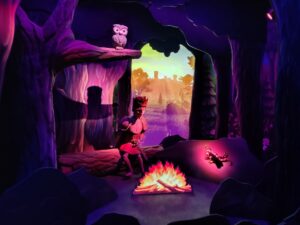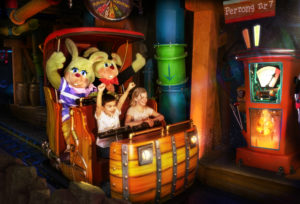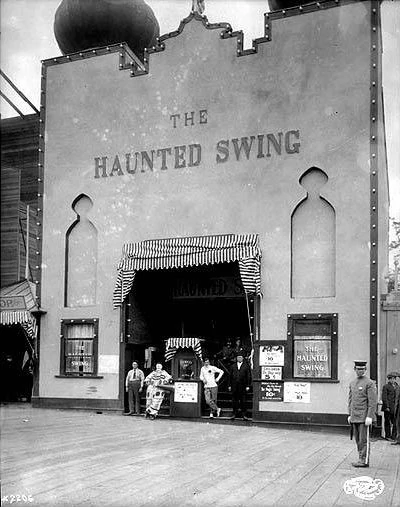
A good show ride can be just as immersive as a good dark ride. But there is one show ride that stands out as it does not require any kind of multimedia for a good show: the so-called Madhouse. The first modern Madhouse, Villa Volta, opened in 1996 in Efteling (The Netherlands). This ride type was heavily inspired by a ride that had been around for a very long time: the Haunted Swing. In this first part of a multi-part special about Madhouses, we’re taking you back in time to see the origin of this vertiginous attraction.
Going back to the very origin of the haunted swing brings us to San Francisco in 1894. In that year, the city hosted a world fair: the California Midwinter International Exposition, also referred to as Midwinter Fair. They did not only bring forth new technologies and buildings, but also sparked new techniques used for entertaining visitors. That made the Midwinter Fair the perfect place for American inventor Amariah Lake to present his latest invention: the ‘Illusion Apparatus’. He constructed a building on the Midway of the fair, and placed a swing inside. However, this was not a normal swing, which visitors of the fair were already familiar with. This one turned the whole room upside down, as if it came straight out of a fantasy novel. Lake expected that his invention would blow the minds of its visitors, and he was right: they could not believe their eyes!
One of the visitors who tried out Lake’s invention was Mr. R.W. Wood. He visited the attraction in 1894 and wrote about his experience in ‘The Psychological Review’: “On entering the building we found ourselves in a spacious cubical room, furnished with a sofa, table, chairs. etc., a massive iron safe, and a piano, together with other minor articles. But the most conspicuous object was the huge swing, capable of holding forty or more persons, which hung in the centre, suspended from an iron cylinder which passed through the centre of the room”.
The illusion of the room being turned upside down worked. It left people wanting to ride again, trying to understand the workings of the Illusion Apparatus. The key element was that the room in which the swing was suspended rotated as well: both the swing and the room were mounted to a beam that ran through the central axis of the room. The combination of the swing going back and forth, and the room rotating around it, created the strong illusion of the room being upside down, leaving the visitors amazed of the illusion. But even when people understood the workings of the ride, they were still amazed, as R.W. Wood says: “The curious and interesting feature however, was that even though the action was fully understood, as it was in my case, it was impossible to quench the sensations of ‘goneness within’ with each apparent rush of the swing.”
The Illusion Apparatus was the first incarnation of what would retroactively be called the Haunted Swing. After the Midwinter Fair, Lake moved his Haunted Swing to Europe and afterwards back to the United States, before eventually settling in Atlantic City, New Jersey. While travelling, his invention inspired many entrepreneurs to build their own Haunted Swing and the rides have been appearing ever since, like at the 1909 Alaska-Yukon-Pacific Exposition in Seattle.
The workings of Lake’s Illusion Apparatus
Unfortunately, Lake’s original ride, nor the other versions of that period still exist. Luckily, Lake decided to patent his invention and the patent includes a description and drawings of the technical workings. This enables us to look into how the very first Haunted Swing worked, using the following images that were derived from his patent.
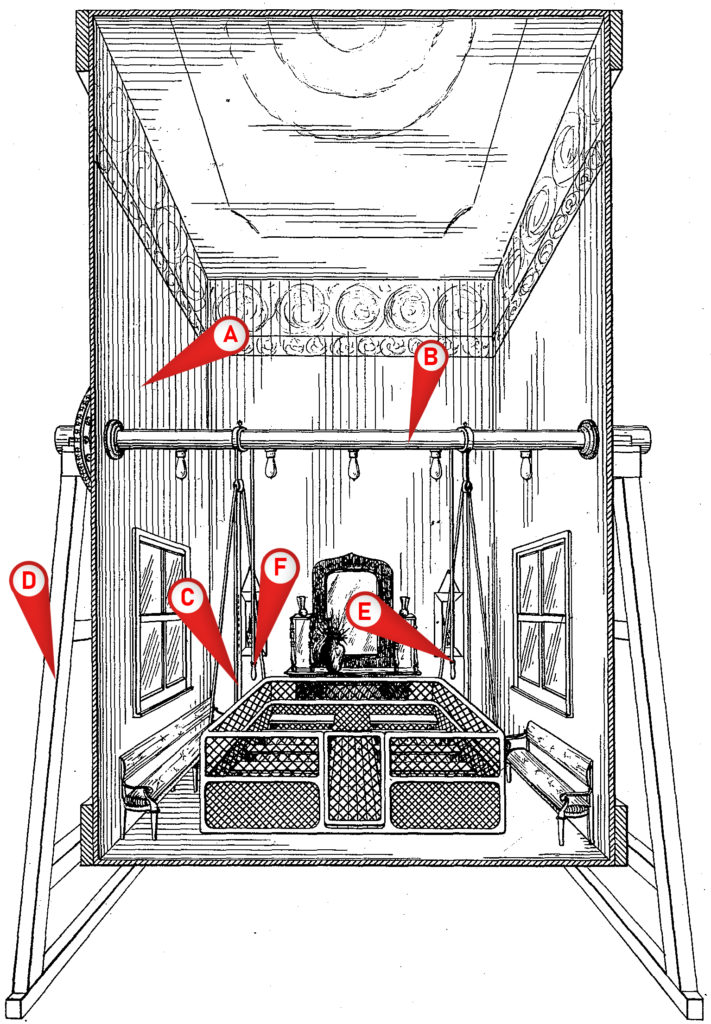
The image above gives a clear overview of the installation, with both the room and the swing being clearly visible. As can be seen, both the room (marked as A) and the swing (marked as C) are attached to the same central beam (marked as B). With the beam running through the central axis of the room, both the swing and the room can rotate around each other, creating the illusion of the room turning upside down. The whole construction of the room and swing is standing on a metal frame (marked as D), lifting the whole installation from the ground and allowing the room to rotate.
Moreover, the drawing illustrates the interior of the room. As Wood’s description already mentioned, the room was completely decorated as if it were a normal room. The fact that this room was square-shaped (contrary to later incarnations of the ride) probably helped to give it a normal feeling, like it could be a room in any house. The whole room was lit by lamps, that could either be gas or electrical, hanging from the central beam. Note the two ropes (marked as E and F) coming down above the swing, we will get to these later.
Lake knew that the experience of his invention would not be the same if people could see the workings of the apparatus from the outside. The patent specifically states: “The apparatus as thus constructed is intended to be erected within a suitable building so that it is entirely shielded from the view of observers on the outside”. Visitors of Lake’s invention would have no clue what was about to happen. Guests could reach the swing inside by using a bridge (marked G on the next image, bottom left). The door would close and the bridge would be withdrawn.
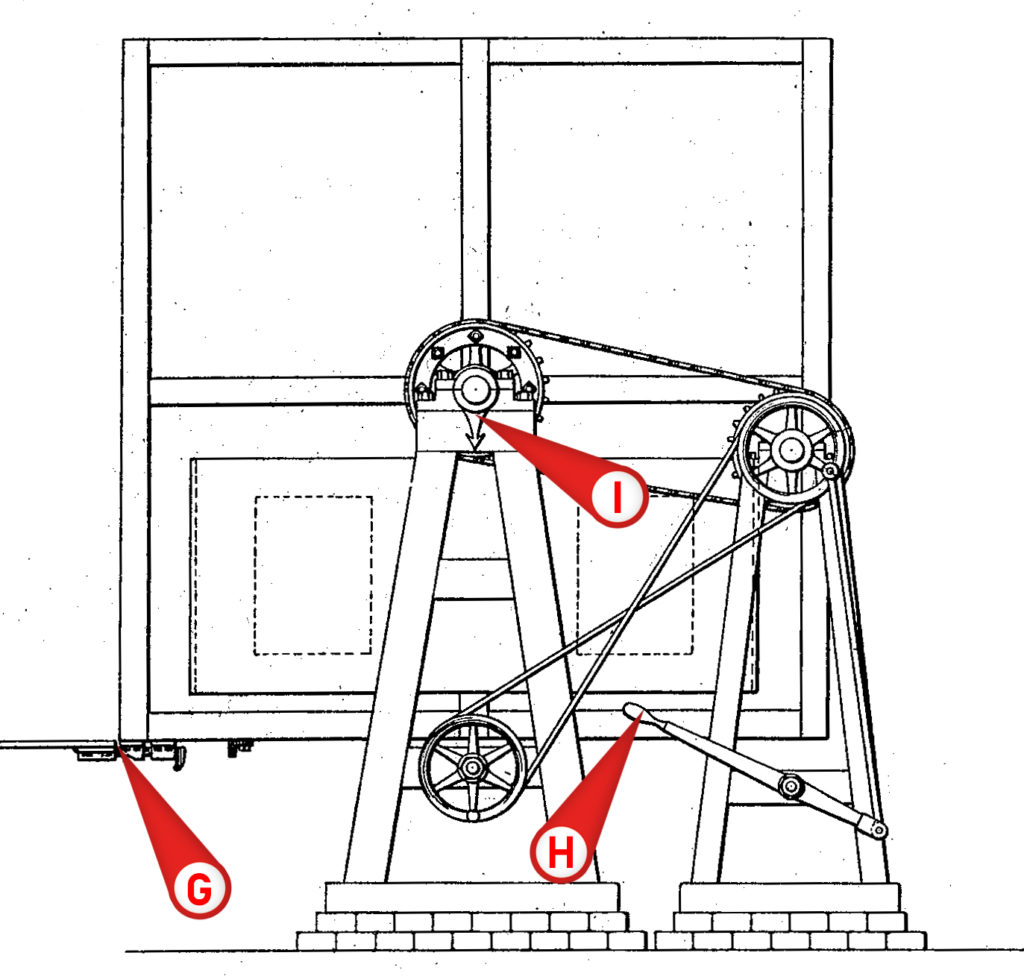
Although engines were already invented at the end of the 19th century, they were still very expensive. This is why Lake’s Illusion Apparatus was manpowered and operated by two employees. One of the employees would be standing on the swing and a second employee would take his place on the outside of the box.
When the ride starts, the employee on the swing would start to pull on cord E (see image 1). This would make the swing rock back and forth inside the box. The reason for this might have been to give guests the idea that they were on a ‘regular’ swing, but also indoors.
After a short while, the employee would use cord F (see image 1) to signal his colleague outside of the box. That employee would start the rotation of the box by using lever H. The employee on the outside of the box was able to see the movement of the swing, which was indicated on the outside by arrow I.
The Illusion Apparatus was a clever invention, one that arguably could be seen as the world’s first show ride. It became a very popular ride, soon to be known under its popular name: ‘Haunted Swing’.
Haunting across the ocean
Besides the Midwinter Fair, Amariah Lake also debuted his swing at the World’s Fair in Antwerp, Belgium, in that same year of 1894, demonstrating the ride to the European market. While there are no known examples of Lake-built swings in Europe, it did surely inspire the Europeans. It was only a year later, in 1895, that the first European version opened under the name ‘Hexenschaukel’ (German for Witches Swing). This installation premiered at the Oktoberfest in Munich, Germany, and would travel the German fair circuit for many years to come. The Hexenschaukel differs from Lake’s original version on two major points: the drum of the swing was no longer shaped like a cube, but as a pentagon. This caused the ride to have a much smaller turning circle, making for a more compact design. The second difference was the lack of any real props: the Hexenschaukel has a painted interior instead.
The German Haunted Swing caused similar reactions amongst German visitors as it had done to the fair visitors over in the States. It even resulted in some scientists having to explain the workings of the ride to the general public. The ride caused a small surge of travelling Haunted Swings to pop up all over Germany. The original Hexenschaukel is still in operation on the German fair circuit, mostly appearing at Oktoberfest in Munich.
The 1960s saw a new era for the Haunted Swing when two German manufacturers started to produce their own versions. Installations of Schwingel, founded by engineer Paul Schwingel and Metallbau Emmeln appeared in several European countries, such as the Netherlands, Belgium, Austria and Italy. These installations were not designed to travel and stayed at most parks for many years.
These versions of the Haunted Swing were based on the pentagon-shaped design of the Hexenschaukel and its painted interiors. All mainland European Haunted Swings used the pentagon-shaped design and no records show if they used any sorts of props or sets. Though some designs, such as Spukhaus at Taunus Wunderland do have small props, these boil down to being a semi-3D representation of furniture on the wall rather than a furnished set.
This rise of popularity in Haunted Swings didn’t go unnoticed and the swings would quickly cross the pond and reach the United Kingdom. The British named their version of the ride Ribtickler, and made some changes to the general design. Most Ribticklers have an entrance on the side of the drum instead of on the head. They are often not pentagon-shaped, but feature six sides (hexagon) or even more. The design of these installations is more abstract, based on optical illusion instead of a themed house. Ribticklers are mostly travelling models and many of them still travel the fair circuit in the United Kingdom.
One manufacturer wanted to dig more into Lake’s original version: the team of Blackpool Pleasure Beach. Unsurprisingly, the first version of their haunted swing would debut in 1955 at Blackpool Pleasure Beach under the name Haunted Swing. This ride was cubic in design, just like the Lake version, and did feature more props as opposed to just painted walls. The Haunted Swing is still present at Blackpool Pleasure Beach, but has since been incorporated into the funhouse ‘Impossible’.
The second ride ever built by this team, now named Helters LTD for their operations in Southport, was the Haunted Swing at Southport Pleasureland, also owned by Blackpool Pleasure Beach at the time. Interestingly enough, this swing used the German design instead of Lake’s design like the one in Blackpool. Over time, Southport Pleasureland changed to an overall Moroccan theme. This caused the Haunted Swing to be rethemed to ‘Abdullah’s Dilemma’ in 2003. The ride closed when Blackpool ceased operation of the park in 2006 and was demolished along with the rest of the park.
A closer look into existing Haunted Swings
There are currently eight Haunted Swings still in operation in theme parks across the globe. The operators of these swings maintain their rides well and operate them with great care. We were allowed to take a backstage look at two of them and by means of these insights, we’ll take a look into the detailed workings of a haunted swing.
Verrücktes Waldhaus
Traumland auf der Bärenhöhle is a small theme park in Sonnenbühl in the south of Germany. The park is located on top of a hill that contains a large cave, which grew into a tourist attraction called Bärenhöhle (The Bear’s cave). The park is located right above this attraction and derives its name from it: the English translation of the park’s name is “Dreamland on the Bear’s Cave”. Traumland caters mostly to families with children up to ten years old. It contains a fairy tale forest and multiple rides for the whole family, including a Ferris wheel, a small log flume, the “Marienkäferbahn” roller coaster and haunted swing “Verrücktes Waldhaus” (German for “Crazy Forest House”).
Verrücktes Waldhouse is a travel-model haunted swing that was manufactured in 1977 by Fa. Dietz Fahrzeugbau. The ride travelled the German fair circuit for almost ten years, until it was bought by Hans Gebauer, founder of Traumland. The ride opened in the park in 1987 as “Verhextes Schloss” (German for “Bewitched Castle”). After 35 seasons, the park planned to remove the ride in 2013 and replace it with a small log flume. However, the owners realised the ride was still popular, which made them decide to move the swing to a new location just around the corner. The park refurbished the ride and reopened it in 2014 as “Verrücktes Waldhaus” with a more family friendly theme.


The house is halfway hidden behind a wall that is decorated with forest animals and friendly trees. Riders enter through one of two doors that are located in a shed in front of the house. This shed also serves as the operator’s booth. Above the shed, the top of the house is visible.
The house itself is pentagonal shaped and as explained in the previous chapter, not decorated with props. Instead, the walls of the house have painted decorations. The paintings show the interior of a normal room with cupboards, windows, doors towards other rooms of the house. Moreover, a wide variety of forest animals seems to be living inside the room.
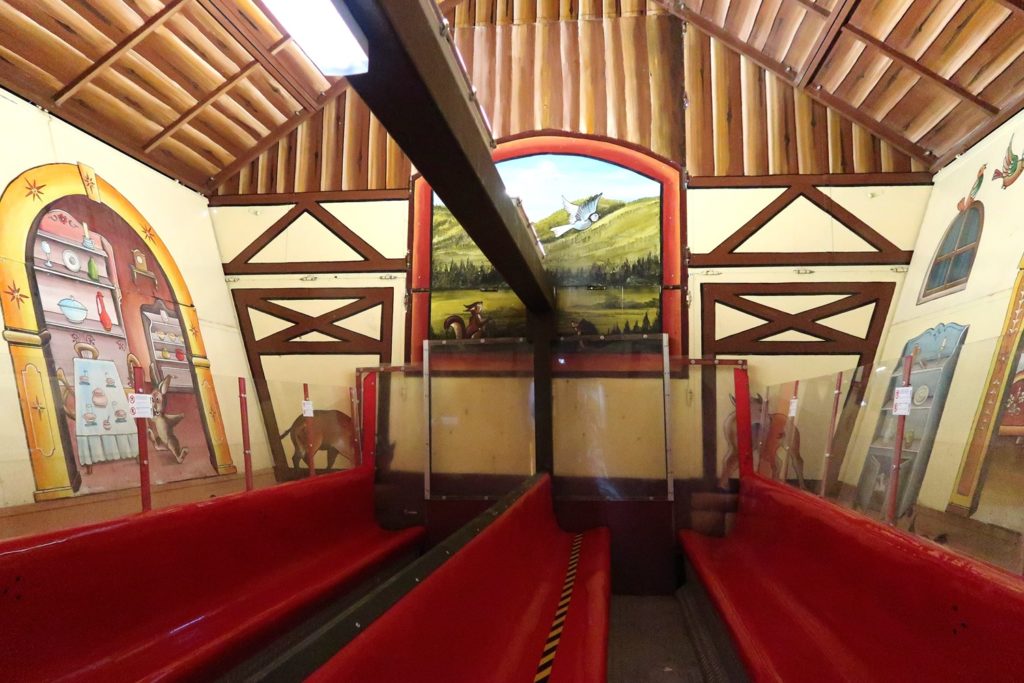
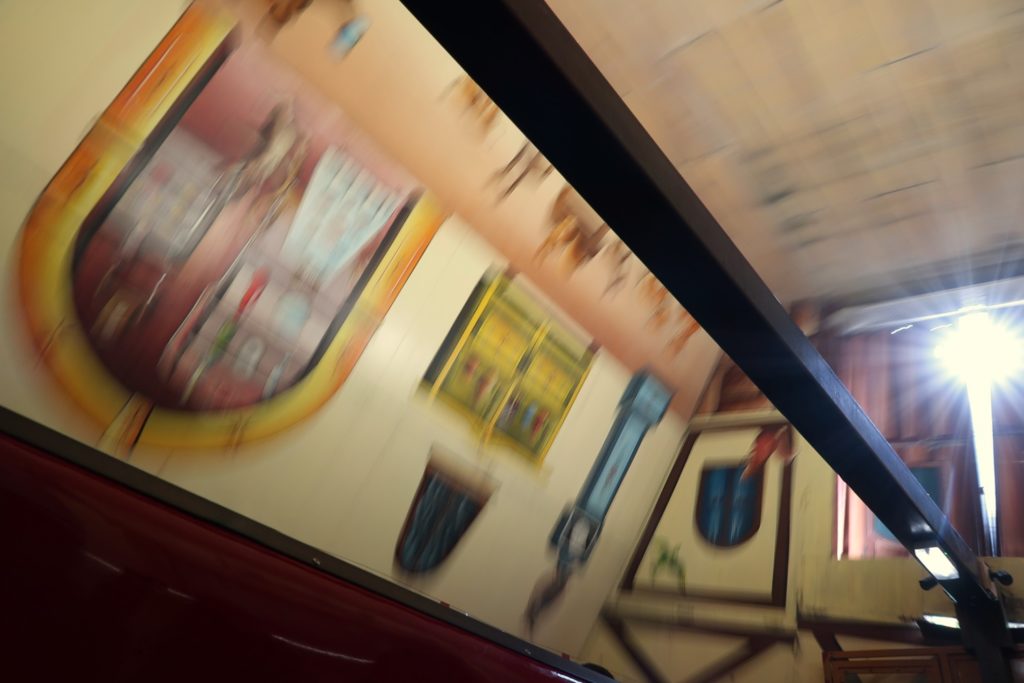
Like many of the European Haunted Swings, Verrücktes Waldhaus is not placed inside a building. Visitors to the park can see the rotation of the house from the outside. The engine room is placed on the backside of the ride, away from the visitors’ view. With help from the park, we were allowed to see from the back how the Verrücktes Waldhaus works.
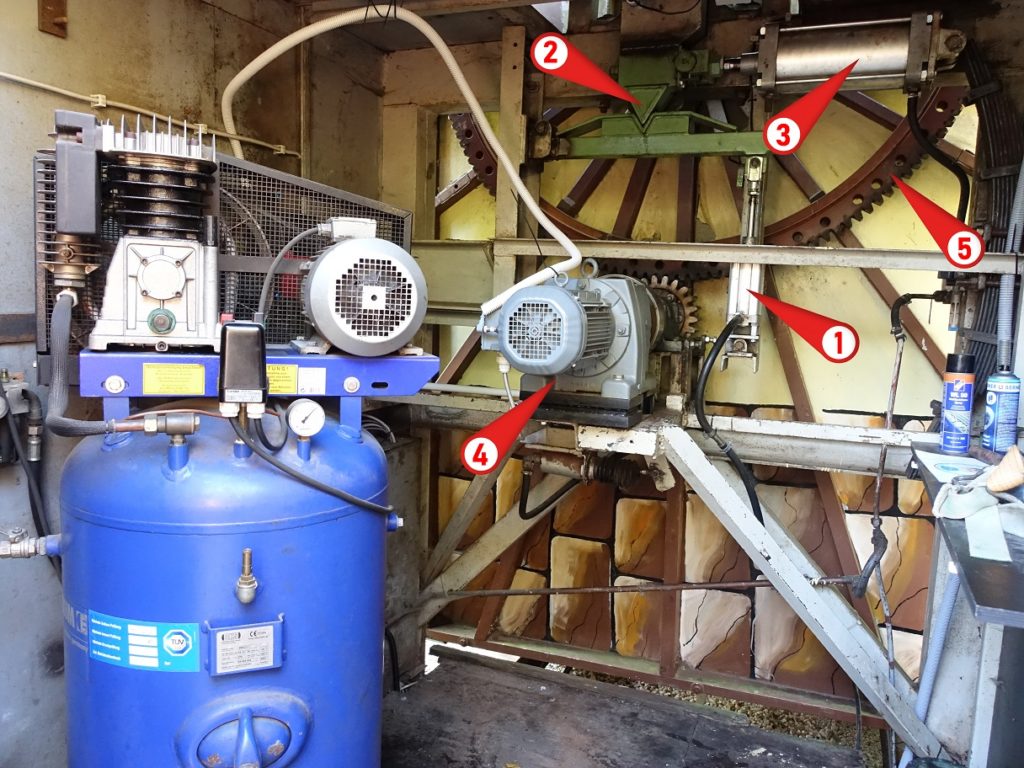
Before the ride can be started, the small plunger (1) must be retracted. This piston is used to lock the swing into position (2) while guests enter or leave the ride. By retracting this piston, the locking mechanism will be loose, enabling the swing to move. Now, the large piston (3) on the top will apply a strong force to the swing, causing it to sway back and forth, along with the effects of gravity. Lastly, the large motor in the middle (4) will start rotating the large gear (5). This gear is attached to the drum of the ride and thus enables the rotation of the drum.
The Verrücktes Waldhaus is operated manually, meaning that it is not programmed in any way. The operator can use several switches on the control panel to operate the ride. A typical ride starts with the piston that gives the impulse to the swing, followed by the start of rotation of the drum. When the operator sees that the swing has (almost) lost its motion, he or she gives the piston another impulse. Around the same time the direction of the drum rotation will be reversed. The next time the swing runs out of energy, the drum is stopped in its regular position and the swing is locked. This marks the end of the ride.
The operator can see the location of the swing from outside of the ride. There is a pointer above the entrance of the drum that will point in the direction of the swing, just like there was in Lake’s original design. In case the swing is out of balance, the operator can give a short pulse to the large piston to put the swing horizontal again, before locking the swing again. The operator can lock or unlock the swing from its straight position by opening or closing an air pressure valve underneath the operating panel.
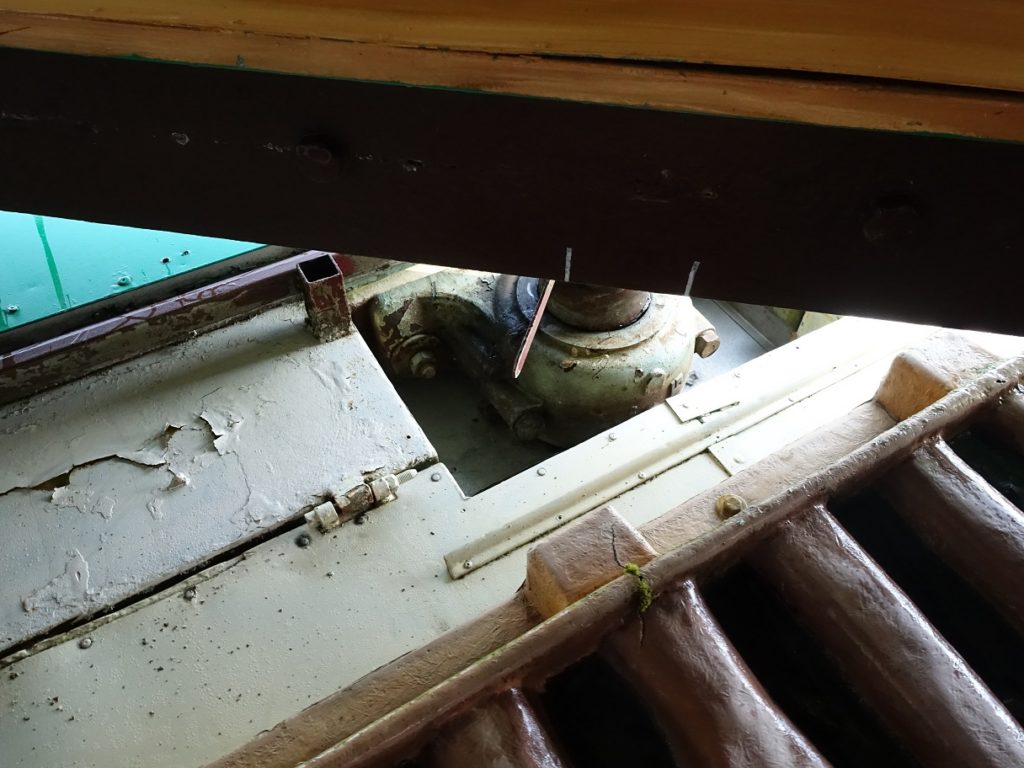
You can see the ride being operated in the backstage video we took here:
Verrücktes Waldhaus is a European styled Haunted Swing in all of its forms and with its outdoor drum, it is the last of its kind in a theme park. The ride is loved among the visitors of Traumland and the park treats the ride well. Unfortunately, the future plans do not feature Verrücktes Waldhaus in the long term, but the park recognises its historic value and is looking for a suitable buyer for the ride. Hopefully, we will be able to ride Verrücktes Waldhaus again one day in a different park.
Spukhaus
Taunus Wunderland, located in Schlangenbad (west of Frankfurt am Main), is owned by the showmen family Barth, best known for operating the five loop roller coaster ‘Olympia Looping’ on the European fair circuit. The park contains many family friendly attractions, such as the Wilde Maus roller coaster, a large log flume and two DRdb noted rides: the motion simulator ‘Wundergleiter Simulator’ and of course their haunted swing ‘Spukhaus’.

The former owners of Taunus Wunderland opened their haunted swing, an installation by Schwingel, in 1979 as “Geisterhöhle” (Haunted Cave). Contrary to most haunted swings in Germany, the park already concealed the drum of the ride inside a building themed like a cave. The park was acquired by the Barth family in 1997, who decided to update their new property step by step. In the early 2000s, Geisterhöhle was completely rethemed: the swing was redesigned and a completely new building was erected around the installation. The update was entirely carried out by the team of Taunus Wunderland, who decided to call the rethemed ride Spukhaus.
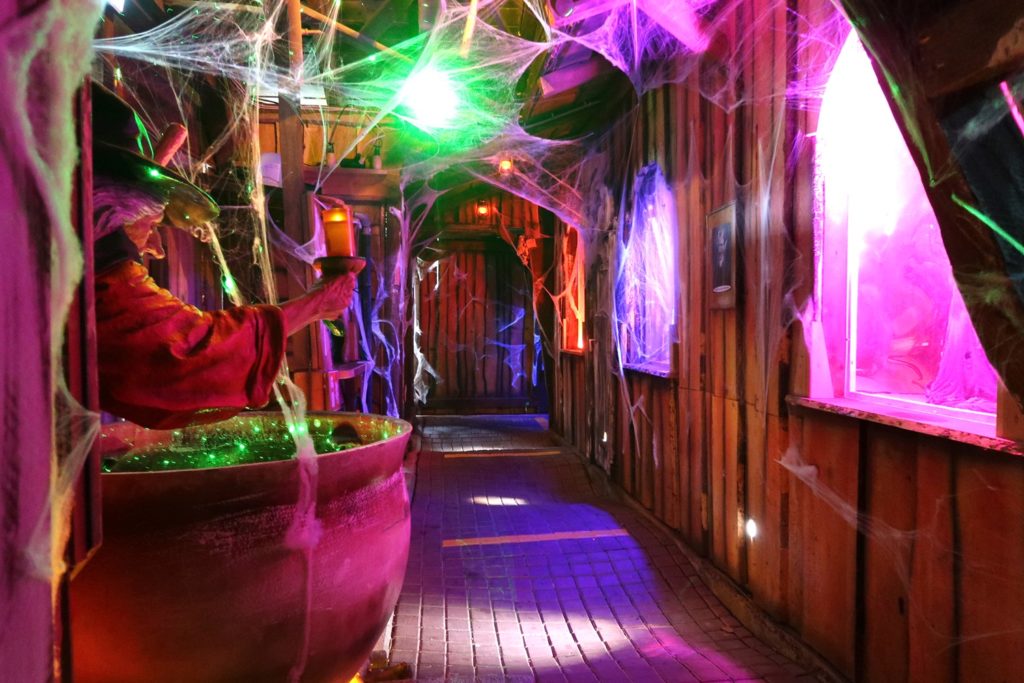

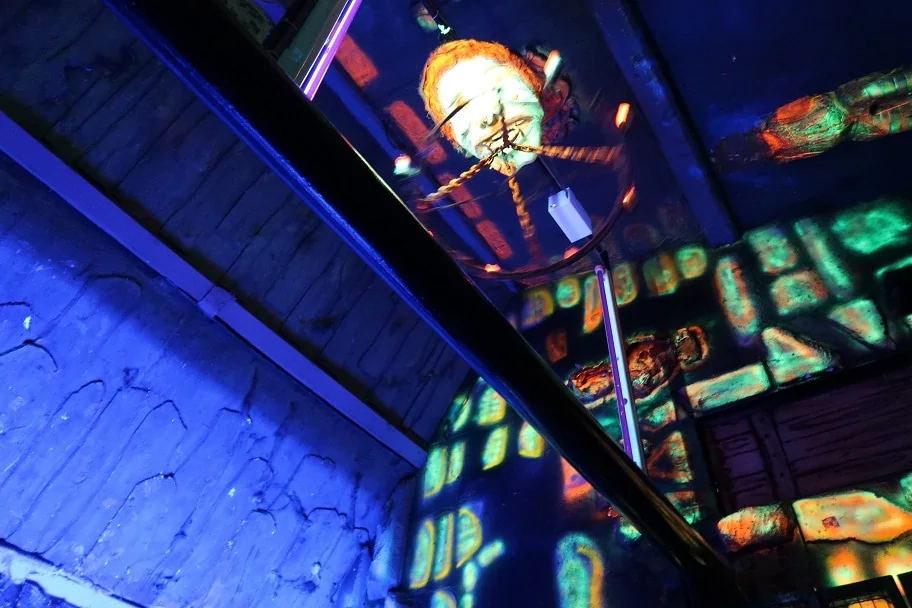
Even though the theme of Spukhaus differs from the version in Traumland auf der Barenhöhle, the ride looks technically the same at first glance. The drum of Spukhaus also has a pentagonal shape with two doors and a similar swing in the middle. Following the ghost house theme of Spukhaus, the ride is a lot darker than Verrücktes Waldhaus. The interior of the drum uses mostly fluorescent paint with blacklight-lighting, giving a spooky atmosphere rather than the family-friendly Waldhaus.
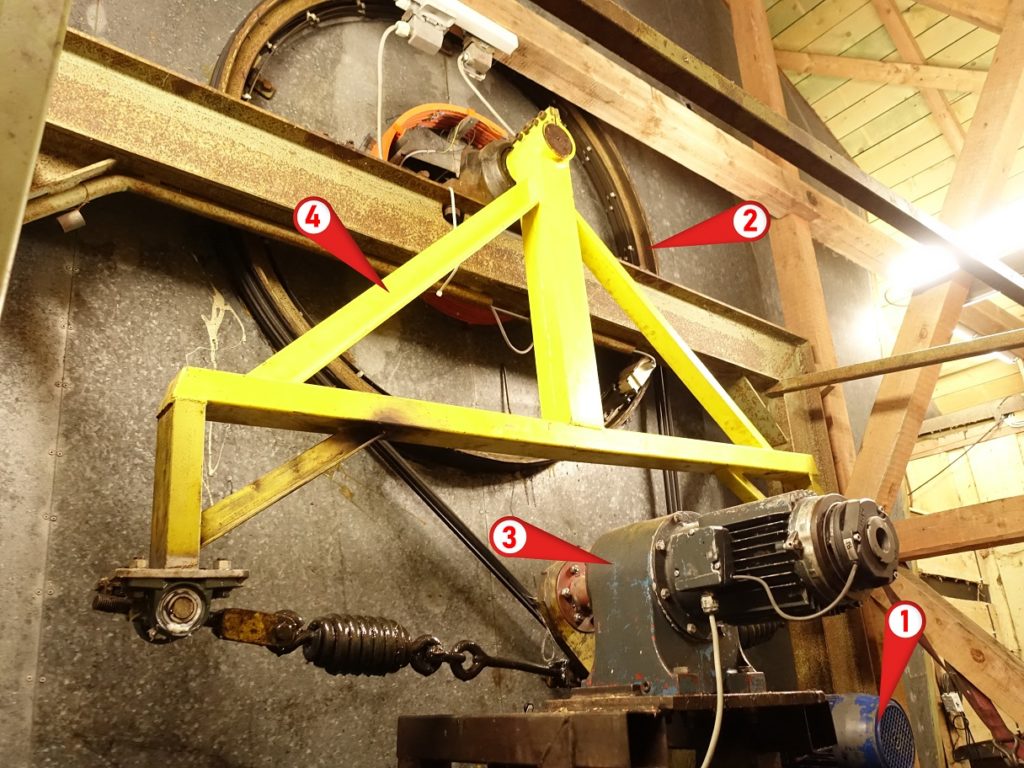
The mechanism of Spukhaus differs from Verrücktes Waldhaus in several ways. Spukhaus is driven by two electric motors. The first motor (1) drives a pulley that will start to rotate the drum (2). The second motor (3) has a droplet shaped plate (known as cam) attached to it. Two arms that are attached to the tip of the drop, will sway left and right while this motor is in motion. This will create the motion of the swing. With this mechanism, Spukhaus creates a more balanced swinging motion when compared to Verrücktes Waldhaus, which only gives the swing a short impulse to get it going.
Spukhaus is operated with a program. After the riders have boarded, the electronically monitored doors to the swing will close. The operator starts the ride by pressing a green button which will cause the ride to automatically start the swing, turn the drum, reverse the drum and then eventually stop.

The staff of Taunus Wunderland have taken good care of their Haunted Swing. Just like Traumland, they recognise its historic value and want to keep it part of the park. They have been maintaining the ride for over 40 years and it is still in good condition.
The final Haunted Swings
For a long time, Europe was the centre of development for Haunted Swings. Soon, the space-efficient European version also became the standard in the United States. Two installations of this type of Haunted Swing are still in operation in the United States: Bug House at Arnolds Park (Iowa) and Dutch Wonder House in Dutch Wonderland (Pennsylvania).
The 80’s however, brought a change in the United States when Arrow-Huss debuted their version of the Haunted Swing, called ‘Magic Room’. Arrow-Huss was formed after Huss Machinefabrik (Germany) bought the bankrupt Arrow Development company (U.S.A.). Under this name, only one installation was manufactured which debuted as simply ‘Magic Room’ at the Louisiana World Fair of 1984 in New Orleans (U.S.A.). This haunted swing interestingly enough lacked the swinging part of the ride, and thus consisted strictly of a drum rotating around stationary riders.
After Arrow-Huss fell into another bankruptcy in 1985, Arrow employees were able to create a new company, called Arrow Dynamics. This company produced a second installation for Hersheypark in 1987, called Frontier Magic House. The design of the Magic Room was more like Amariah Lake’s original design and featured a cube-shaped drum with scenery along the walls.
The Magic Room of Louisiana World Fair was moved to Carowinds (U.S.A.), where it opened in 1985 as Blackbeard’s Revenge. The Frontier Magic House of Hersheypark operated for 3 seasons between 1987 and 1989. It is unclear what happened to the ride, but sources say the ride was bought by a buyer from China. Both rides seem to have been scrapped by now.
1986, between the two Arrow(-Huss) installations, was the opening year of another very special haunted swing in the United States. A small amusement park in New Hampshire named ‘Clark’s Bears’, formerly known as Clark’s Trading Post, has built their own Haunted Swing. They called it Merlin’s Mystical Mansion, and opened it in 1986.
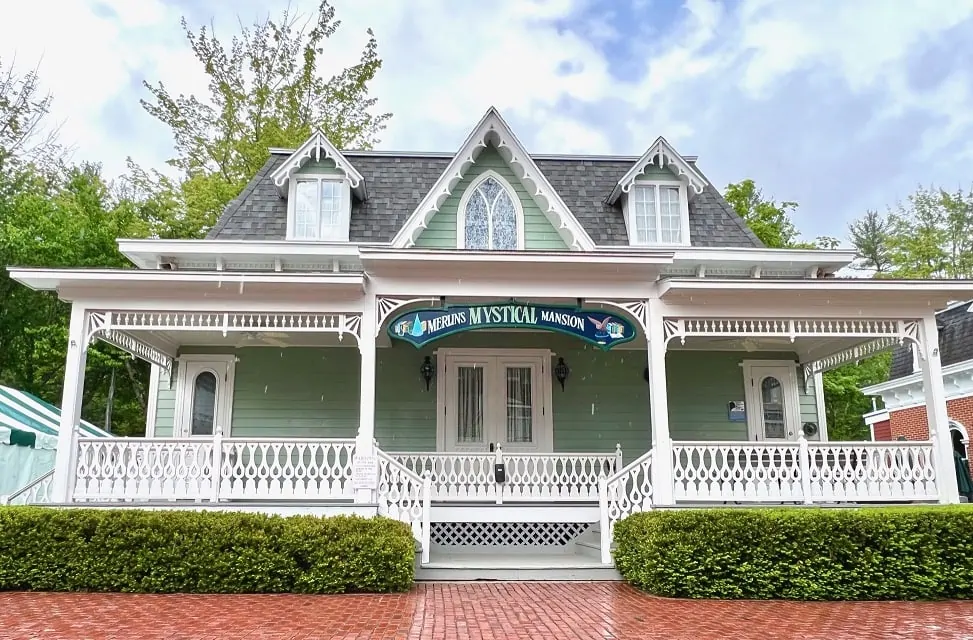
Merlin’s Mystical Mansion is unique in its extensive theming and storytelling, something rarely found among original haunted swings. The ride contains a backstory, where visitors are welcomed by Merlin’s apprentice while Merlin himself is on an important quest. The story tells that the mansion that you will enter is built on a gravity point. Gravity points allow smaller objects like the riders to cling to the axis like a magnet and larger things like the room to revolve. An added benefit with a gravity point is that time stands perfectly still: while inside, one does not get any older.
The room itself is extensively themed and resembles a normal room in any normal house. In fact, interior design goes even further back to the original design of Amariah Lake, using a cubic drum. Moreover, the room has been extensively furnished with chairs, a piano, cupboards and more items, just like the description in Lake’s patent. This creates a highly immersive atmosphere that sets Merlin’s Mystical Mansion apart from all the other Haunted Swings.
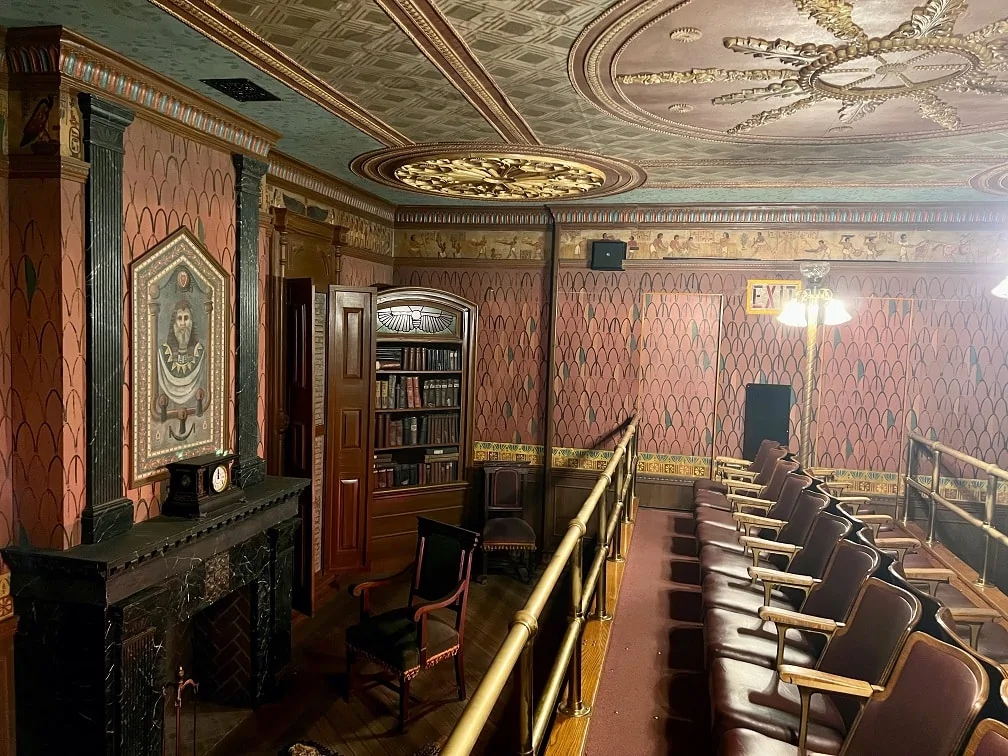
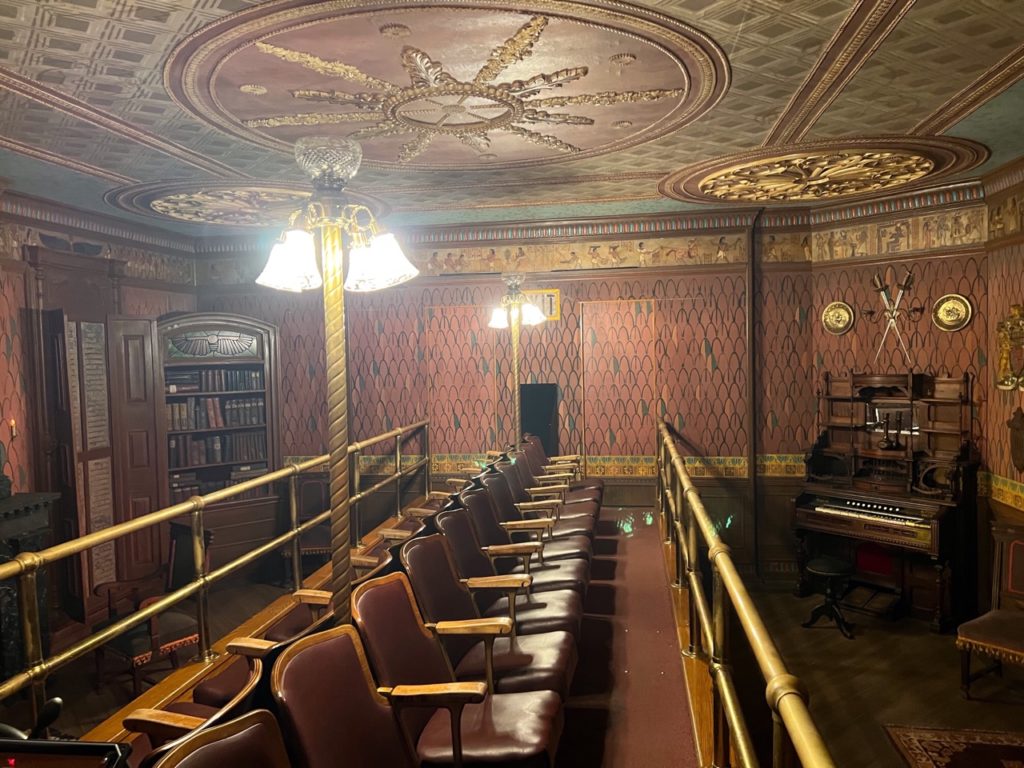
Merlin’s Mystical Mansion was the last haunted swing to be built before the opening of the first Madhouse. With its storyline, shape and decoration, it stands out from the other Haunted Swings. The fact that it resembles so much of the original design from 1894 makes this Haunted Swing extra special.
The future of the Haunted Swing
Haunted Swings have been popular rides for over 100 years. However, since the ‘90s, we’ve seen a lot of them disappear. Perhaps this had something to do with a Dutch theme park designer that was inspired by a haunted swing that once stood in Luisenpark (Germany). He liked the idea, but wanted to incorporate it in a completely different way. Read more about the development of the Madhouse in the second part of our Madhouses special, coming soon.
We would like to thank Tobias Ehe and the people of Traumland auf der Bärenhöhle, as well as Maximilian Wegner and the people of Taunus Wunderland for the backstage tours at Verrücktes Waldhaus and Spukhaus. We also like to thank Robert Wetherell of Clark’s Bears for providing information and photos of Merlin’s Mystical Mansion.
© Dark Ride Database
Article by: Quintus, Erik & Luc
References
- Lake, A. (1893) “Illusion Apparatus”. Patent No 508.227. Patented Nov. 7 1893.
- Silverman, S.M. (2019) “The Amusement Park: 900 years of thrills and spills, and the dreamers and schemers who built them”, New York: Black Dog & Leventhal Publishers
- Anderson, Norman D. (1992) “Ferris Wheels: An Illustrated History”, Bowling Green, OH: Bowling Green State University Popular Press.
- Wood, R.W. (1894) “The ‘Haunted Swing’ Illusion”. The Psychological Review, 2 (3). Washington, DC: American Psychological Association.
- Adams, A & Risley, Sarah A. (1915) “A Genealogy of the Lake Family”.
- https://oktoberfest-guide.com/attractions/hexenschaukel/
- http://hexenschaukel.de/
- https://www.amdigital.co.uk/about/blog/item/haunted-swing

